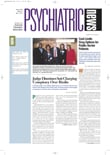The term “moral insanity” is unfamiliar to psychiatrists today, but it was an accepted diagnosis in Europe and America throughout most of the 19th century. As late as 1883, the American Journal of Insanity (forerunner of the American Journal of Psychiatry) published an article titled “Moral Insanity.”
Individuals who retained their intellectual capacity but harbored strange and unrealistic ideas had puzzled European physicians of the 18th century. Philippe Pinel (1745-1826) termed the condition manie sans délire. Jean-Etienne Esquirol (1772-1840) retained Pinel’s ideas. Benjamin Rush (1745-1813), considered the first American psychiatrist, had studied in Britain and visited Pinel in Paris. In his 1812 book Medical Inquiries and Observations of the Mind, he used the term “alienation of the mind.” Later writers believed there was confusion between hypomania and moral insanity.
Dr. J.C. Prichard (1786-1848) of England is credited with being the first to use the term moral insanity. In 1835 he wrote: “There is a form of mental derangement in which the intellectual faculties [are uninjured], while the disorder is manifested principally or alone in the state of feelings, temper, or habits. . .The moral. . .principles of the mind. . .are depraved or perverted, the power of self-government is lost or greatly impaired, and the individual is. . .incapable. . .of conducting himself with decency and propriety in the business of life.”
In his 1939 Salmon Lectures in New York, Professor David Henderson of Edinburgh gives credit to Isaac Ray (1807-1881) for distinguishing between intellectual mania and moral mania. Ray believed the latter corresponded to Pinel’s manie sans délire. Ray’s opinions exerted considerable influence in courts of law.
The term “moral insanity” was still used in 1881 during the trial of Charles Guiteau, who had assassinated President Garfield. One psychiatrist for the defense said Guiteau suffered from moral insanity, and another testified he was a moral imbecile.
The term “psychopathic inferiority,” first used by J.L. Koch in Germany in 1888, replaced moral insanity as a diagnosis. Henderson defined the psychopathic state to apply to individuals “who conform to a certain intellectual standard but who throughout their lives exhibit disorders of conduct of an antisocial or asocial nature.” He termed it a true illness.
The term “psychopathy” was accepted in America. William A. White, a former superintendent of St. Elizabeths Hospital in Washington, D.C., described it in his 1935 textbook Outline of Psychiatry, as did Philadelphia psychiatrist Edward Strecker, M.D., and Franklin Ebaugh, M.D., of the University of Colorado in their 1935 textbook. In 1941 Hervey Cleckley, M.D., a psychiatrist at the University of Georgia Medical School, published The Mask of Sanity in which he described such cases. He believed the condition was a true illness.
The first psychiatric nomenclature in America, prepared in 1917 by the National Committee for Mental Hygiene in collaboration with the American Medical Psychological Association (forerunner of APA), proposed the rubric “psychosis with constitutional psychopathic inferiority.” The eighth revision in 1934 used the term “psychopathic personality” with subtypes pathological sexuality and emotionality, with asocial or amoral trends.
APA assumed responsibility for the Diagnostic and Statistical Manual in 1952 and included the renamed “sociopathic personality disturbance” with subtypes antisocial reaction, dyssocial reaction, and sexual deviation. The 1968 revision uses “antisocial personality,” and DSM-III and -IV retain this rubric. ▪
